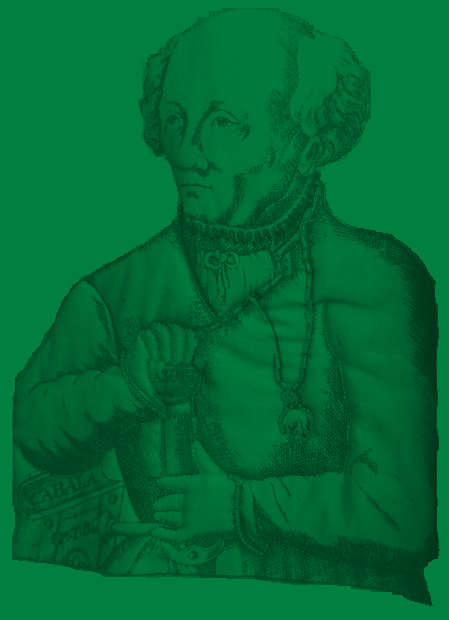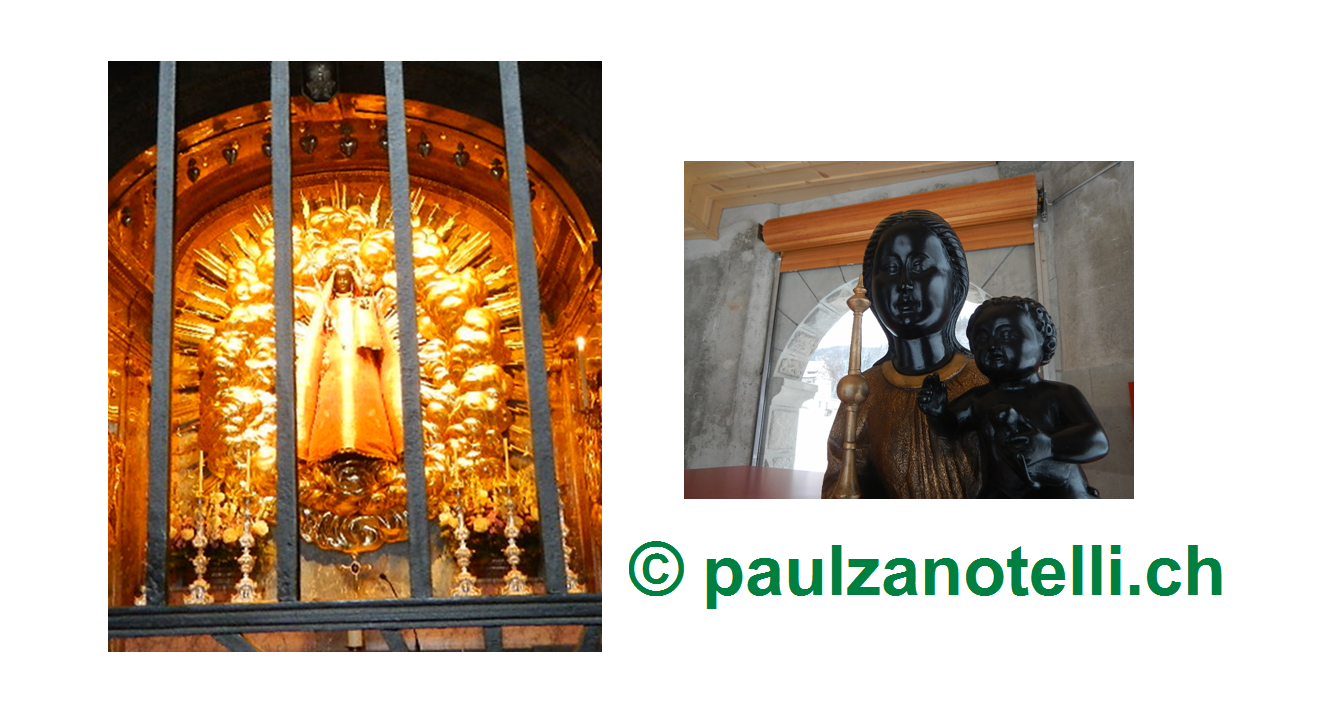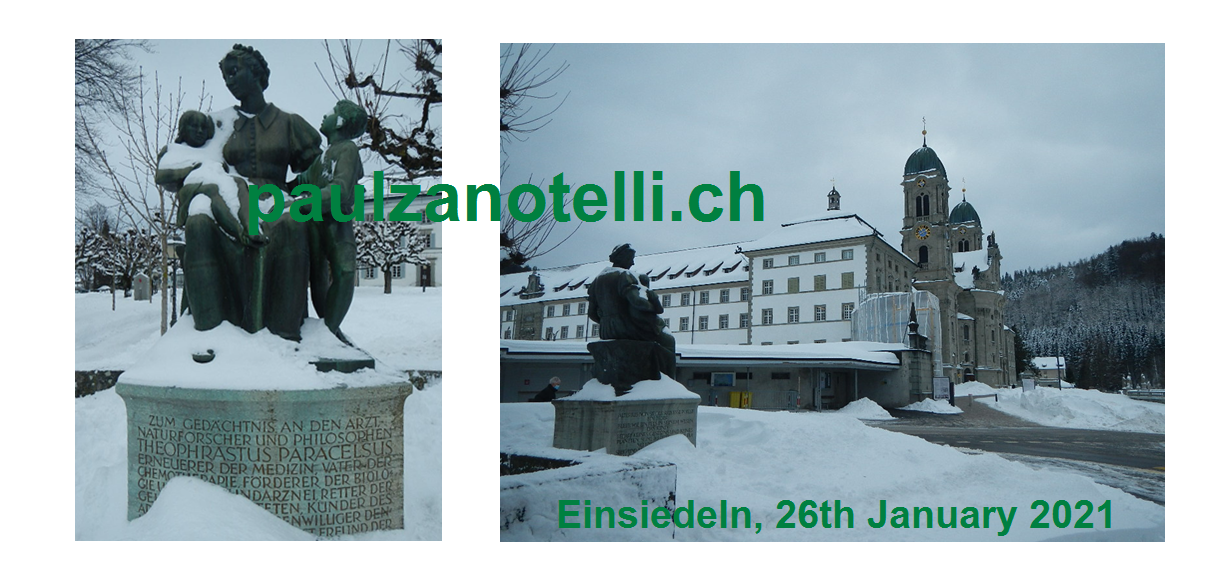
Famous portrait of Paracelsus displayed on some tissue-like material in one of the windows of the Paracelsus Apotheke in Einsiedeln (based on the engraving by Augustus Hirsch-vogel, 1540)
On reading aloud a passage attributed to Paracelsus only three times (instead of five)

One
of the most extraordinary individuals born in this country, Aureolus
Philippus Theophrasus Bombast, better known under the nickname of
Paracelsus, is said to have come to this world in a hamlet near
Einsiedeln. This is why a statue was erected in 1941 in close proximity
to this small town’s ‘towering landmark’ (the famous cloister perched on
Einsiedeln’s lower hill and which houses the-as-much-famous black
virgin statue) to commemorate the memory of this incredibly
unusual
16th century physician, alchemist, nature lover, writer (in the
vernacular, not in Latin!) and fearer
of God.

So after having seen my wife off at the airport of Zurich, I decided to go ahead with the plan that had crossed my mind only the evening before our departure to Zurich very early on Tuesday, which was to make use of my day pass (which would allow me free rides on trains, buses and boats, if owned by the state) to go and pay homage to the memory of one of Europe’s most famous alchemists, this in front of the statue erected in his honour in the small but highly picturesque alpine town of Einsiedeln.
Upon leaving the railway station, it was a swift walk (maybe not even fifteen minutes) to the statue, which (as I had realised 5 years earlier –yes, I am a ‘repeat’ visitor) stands at the entrance to a park leading to a school. However, to my dismay, some of the snow which had been cleared from the road by the snow blowers had been left, rather irreverentially, in a heap several centimetres deep at the spot most convenient for this purpose – the small, half circle-like area in front of the monument to the memory and achievements of Paracelsus.
As I felt that my little ‘pilgrimage’ would be wasted if I did not step close to the statue, I climbed on to the heap only to experience my legs sink into the snow. As I knew that I would be encumbered with my wife’s snow jacket (which would have been of no use to her in her tropical country of origin, in Southeast Asia), I had not brought with me my copy of the best one-volume anthology of the works of Paracelsus (Lebendiges Erbe: Eine Auslese aus seinen sämtlichen Schriften; Wegweisendes und Besinnliches für den Menschen der Gegenwart. Auswahl der Texte und Bilder sowie die Bearbeitung, die Einführung, die Biographie und das Wörterbuch durch Jolan Jacobi, Zurich, 1942, available in English as Paracelsus: Selected Writings, edited by Jolande Jacobi) because of the extra weight I would have had to carry.

Had I done so, I would have been able to read aloud a passage genuinely of Paracelsus’s pen, other than the following quote (which comes from a contemporary alchemical treatise written in French, namely Alchimie: science et mystique, Patrick Rivière, 2013, p.34), given that it has been attributed by some to ‘Gerhard Dorn, the prominent Paracelsist, or one of his followers, around 1570’ (Nicholas Goodrick-Clarke, Paracelsus by Paracelsus, p.192):
La quintessence est une certaine matière extraite de toutes choses que la Nature a produites et de chaque chose qui possède sa vie corporelle en elle-même, une matière la plus subtilement purgée de toute impureté et de toute mortalité, et séparée de tous éléments. D'après ceci, il est évident que la quintessence est, pour tout dire, une nature, une force, une vertu, et une médecine, à la fois, en vérité, enfermée en toutes choses, mais désormais libre de tout domicile et de toute incorporation extérieure.
Le Quatrième Livre des Archidoxes
[which has been translated in English as follows by the prolific English researcher, author and translator of hermetist and occultist works Arthur Edward Waite (1857-1942):
The quintessence, then, is a certain matter extracted from all things which Nature has produced, and from everything which has life corporeally in itself, a matter most subtly purged of all impurities and mortality, and separated from all the elements. From this it is evident that the quintessence is, so to say, a nature, a force, a virtue, and a medicine, once, indeed, shut up within things, but now free from any domicile and from all outward incorporation.
Arthur Edward Waite, The Hermetic and alchemical writings of Aureolus Philippus Theophrastus Bombast, of Hohenheim, called Paracelsus the Great Paracelsus, 1493-1541, 1894, https://archive.org/details/cu31924092287113/page/n35/mode/2up]
Now had I been like one of these Tibetan monks who
practice tummo outdoors in the Himalayas and had I thus been
ignited by the fire of my devotion to the writings of Paracelsus (which I
cannot be because, for the little I know of them, I often find them too abstruse or even fanciful
to my liking), I would not have wasted this occasion. Like a practitioner
of tummo, I would have been able to endure the wintry cold and
snow and
I would have recited the above excerpt FIVE
times, incantation-like, because quintessence means ‘fifth essence’ in
Latin (‘quinta essentia’) – and it goes without saying that I would love to be able to get to the
quintessence of Paracelsus’s thought…